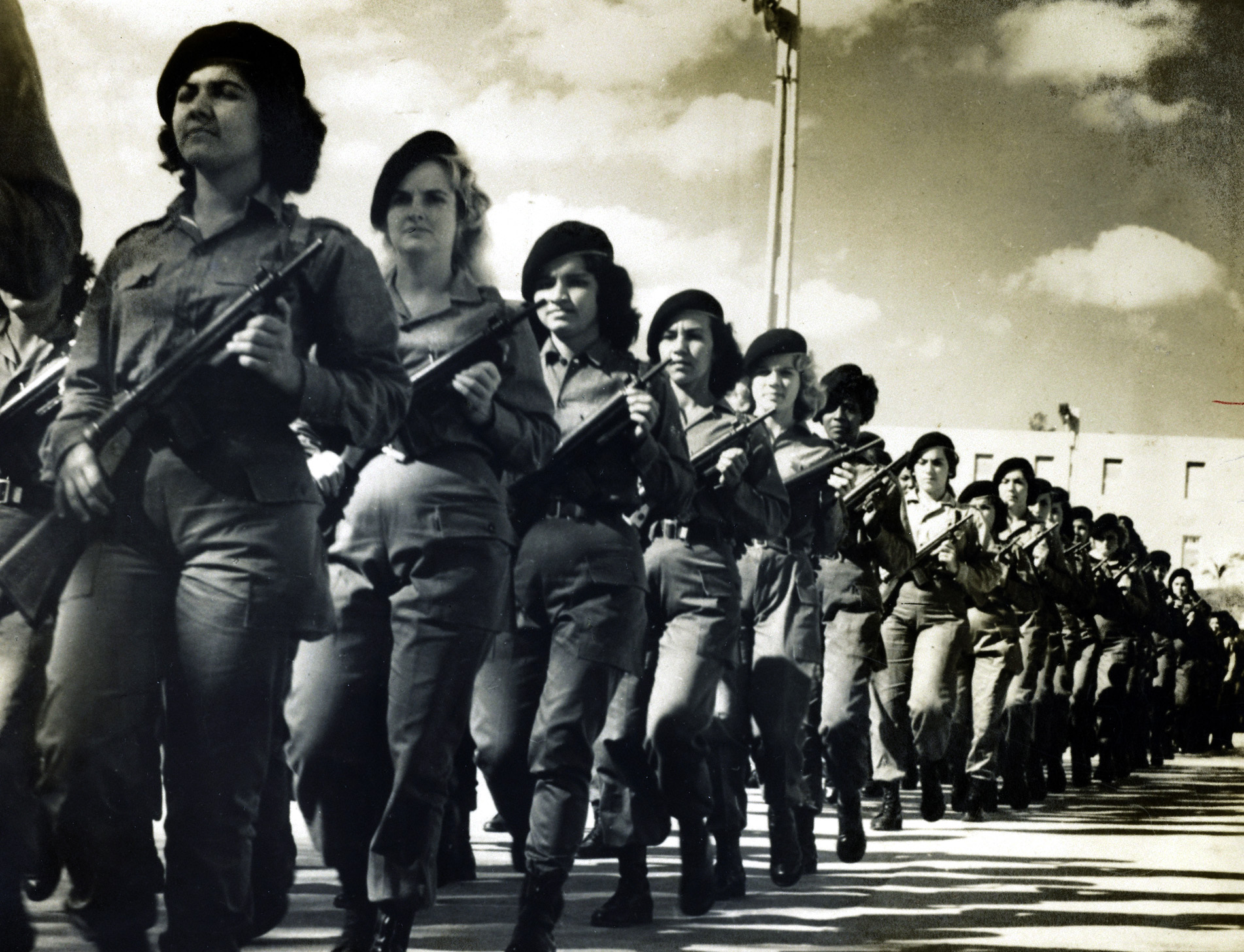“˜A Revolutionary Project’ on Cuba exhibited at Getty

Alberto Korda’s print of female soldiers in Havana’s Plaza de la Revolución, the same place where Korda shot his famous image of Che Guevara, is among the photographs on view at the Getty’s “Revolutionary Cuba: From Walker Evans To Now.”
A Revolutionary Project: Cuba from Walker Evans to Now
Through Oct. 2
J. Paul Getty Musuem, FREE
By Lenika Cruz
May 19, 2011 12:00 a.m.
Each of the dozens of photographs in the Getty Museum’s “A Revolutionary Project: Cuba from Walker Evans to Now” has a label next to it, except one. Standing alone in the middle of a gallery, this image has been parodied and praised on countless t-shirts and magazine covers. This shot of the Cuban revolutionary leader Che Guevara, taken by photographer Alberto Korda, is one of the most reproduced images in the world.
Korda’s famous “Guerillero Heroico,” one of the earliest prints known to exist, provides one glimpse of Cuba as witnessed through the exhibition, which features photographs from three distinct periods in Cuba’s history: before, during and after the country’s 1959 revolution. Evans’ 1933 photographs mark the first period, followed by work from Cuban photographers during the revolutionary period. The exhibition concludes with more recent works of foreign photographers after the withdrawal of Soviet troops from Cuba in the ’90s.
While the Getty houses the largest U.S. collection of Evans’ prints, “A Revolutionary Project” marks the first public showing of his photographs from Cuba, almost 80 years after they were originally taken to be included in a book by journalist Carlton Beales.
Brett Abbott, curator at the High Museum of Art in Atlanta, said the project came about when he learned that Judith Keller, senior curator of photographs at the Getty, was looking to unearth Evans’ Cuba photographs. He wanted to focus on contemporary views of Cuba, so they decided to make one big show to blend perspectives.
Some images in the exhibition, such as Korda’s shot of Guevara, recur throughout the exhibition in the works of other photographers, linking them through a visual code.
“You can see the sections speaking to one another,” Abbott said. “It’s like a dialogue going on across history.”
According to Abbott, Evans’ photographs have a more neutral quality, while the efforts of Cuban photographers during the revolution have a more political bent. Some photos were taken to serve as propaganda to support the heroic iconography of rebel leader Fidel Castro’s movement.
The third segment of the exhibition features the work of three contemporary non-Cuban artists ““ Virginia Beahan, Alex Harris and Alexey Titarenko ““ each of whom interpreted Cuba differently, but with greater attention to conceptualization, Abbott said.
According to Harris, he was influenced by Evans’ belief that photography is essentially about collecting images. Five photographs pick out the bust of Cuban national hero Jose Marti in different settings, while another five are taken from inside of 1950s American-made cars. Other works feature women prostitutes in Havana’s tourist-fueled sex industry.
While Harris and Beahan’s chromogenic prints are vibrantly colored, Titarenko’s are subdued silver gelatin prints like Evans’. He said he used slow shutter speeds to capture the blurry, out-of-time quality of Havana. For Titarenko, the pictures are not about the place itself, but about the people.
“The most beautiful places in the city are those where the ordinary people gathered … where they worked, lived and played,” he said.
Titarenko said he found a strong parallel between Havana and St. Petersburg, where he was born. He said while both are among the most beautiful cities in the world, both have been destroyed by the effects of communism.
“The destiny of Havana is the destiny of my own city,” Titarenko said.
Beahan said she was struck by how immediately Cuba’s history was visually expressed through prevalent signs, billboards and posters. She said she traveled to rural areas and small towns across the island to find a view of Cuba different from the familiar National Geographic-style photos of tobacco fields and school children. She found the stories she wanted in the landscape, from long exposure shots of the Bay of Pigs to the spot where Christopher Columbus landed in 1492.
“I knew I wanted something else, I just didn’t know what it was until I got there,” Beahan said. “I began to think of these pictures as telling stories not only about Cuba’s history, but also about Cuba’s present and the ways in which those ideas bear on their view of the future.”


